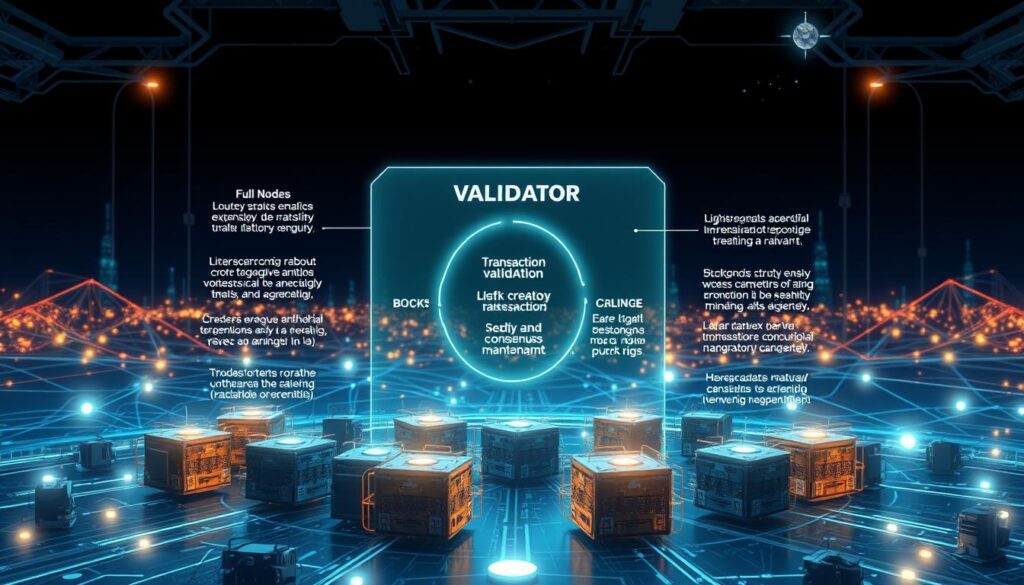Now Reading: Understanding Blockchain Validator Network Consensus Participation
- 01
Understanding Blockchain Validator Network Consensus Participation
Understanding Blockchain Validator Network Consensus Participation

Have you ever wondered how digital transactions stay secure without a bank or central company overseeing them? This guide explores the powerful system that makes it possible. It focuses on the individuals and computers that act as the backbone of decentralized systems.
These specialized participants are essential for verifying and confirming transactions. They ensure everything is honest and correct across a distributed ledger. This process creates a trustless environment where peers can interact directly.
The importance of this role is growing rapidly. Industries from finance to healthcare now rely on this innovative technology. Understanding how these systems work is crucial for both technical experts and business leaders.
This foundational knowledge helps prevent fraud and maintains system reliability. For a deeper look into their function, you can explore this resource on understanding validators in blockchain.
Key Takeaways
- Validators are critical for maintaining security and integrity in decentralized systems.
- They enable trustless, peer-to-peer transactions without a central authority.
- This technology is expanding into many important industries.
- Understanding their role is vital for technical and business decision-making.
- They help prevent fraudulent activities and ensure network reliability.
- Different systems utilize various types of validation methods.
Introduction to Blockchain Validator Nodes
The backbone of trustless digital systems consists of dedicated entities responsible for verifying and confirming transactional data. These specialized participants form the foundation of distributed ledger technology.
What Are Validators and Their Role?
Validator nodes are distinct from regular monitoring nodes. They take responsibility for ordering, checking, and confirming data before permanent recording.
Their function extends beyond simple transaction checking. These guardians maintain system integrity by ensuring only legitimate operations follow established protocols.
This verification process prevents fraud and manipulation. Validators operate as geographically dispersed independent entities.
Historical Overview and Importance
The development of validation emerged from solving the double-spending problem in digital currencies. Early systems used energy-intensive approaches.
Modern validation methods balance security, efficiency, and environmental concerns. The importance of these participants has grown as technology expanded beyond cryptocurrency.
Enterprise applications now rely on accurate transaction validation. This ensures data accuracy and system reliability across various industries.
Fundamentals of Blockchain and Ledger Integrity
The reliability of distributed digital records hinges on a sophisticated verification system that examines every data entry. This process ensures the permanent accuracy of information stored across multiple locations.
Maintaining data trustworthiness requires careful scrutiny of all additions to the system. Specialized participants perform this critical function.
How Validators Secure the Blockchain
These specialized participants protect the system through multiple security layers. They verify that each transaction follows established rules before approval.
One key protection prevents double-spending attempts. This ensures digital assets cannot be used more than once illegally.
The verification process includes checking account balances and transaction formats. Cryptographic signatures confirm each operation’s authenticity.
| Verification Step | Purpose | Security Impact |
|---|---|---|
| Balance Check | Confirm sufficient funds | Prevents invalid transactions |
| Format Validation | Ensure proper structure | Maintains system standards |
| Signature Verification | Authenticate sender identity | Prevents unauthorized access |
Transaction and Block Verification Process
Beyond individual transactions, entire data groups undergo scrutiny. Each block must meet specific size and content requirements.
Validators ensure blocks connect properly to previous entries. This maintains the chronological order and data integrity.
The combined checking of transactions and blocks creates strong protection against manipulation. This multi-layered approach makes the system highly resistant to fraud.
Blockchain Validator Network Consensus Participation
How do scattered computers worldwide agree on a single truth without a boss telling them what to do? They rely on a sophisticated agreement protocol. This system is the heart of a trustless digital environment.

Understanding the Consensus Mechanism
The consensus mechanism is the rulebook for achieving harmony. It defines how independent nodes collectively approve new data. This process ensures everyone has the same record.
Participants must follow specific protocols to cast their votes. These rules prevent conflicts and maintain a single chain of events. The method varies between different digital ledger technologies.
| Consensus Type | Decision Method | Primary Goal |
|---|---|---|
| Proof-of-Work | Computational race | Security through effort |
| Proof-of-Stake | Stake-based selection | Efficiency and scalability |
| Delegated Proof-of-Stake | Representative voting | Speed and governance |
Significance of Active Participation
When nodes actively participate, the system’s health is secured. Their engagement is crucial for preventing fraudulent entries. A sufficient number of honest actors is required.
This collaborative effort stops malicious attempts to alter the ledger. It also ensures all copies of the data remain synchronized. Consistent involvement is the price of integrity.
The significance of this role cannot be overstated. It transforms individual checks into a powerful, unified decision. This is how decentralized systems earn their trust.
Differentiating Consensus Mechanisms in Blockchain
Digital ledger systems employ various agreement protocols to maintain data integrity and transaction order. These methods determine how independent computers reach unanimous decisions about new entries.
Each approach balances different priorities like energy use, speed, and security. Understanding these differences helps select the right system for specific applications.

Proof of Work (PoW) vs. Proof of Stake (PoS)
Proof of Work represents the original validation method. Participants called miners solve complex puzzles using massive computing power.
This energy-intensive process secures systems like Bitcoin. The first miner to solve the puzzle adds the next data group.
Proof of Stake emerged as an efficient alternative. Selection depends on the amount of crypto assets held as collateral.
This approach reduces energy consumption dramatically. Ethereum’s shift to this method cut energy use by 99.99%.
| Feature | Proof of Work | Proof of Stake |
|---|---|---|
| Energy Usage | Very High | Minimal |
| Selection Method | Computational Race | Stake Amount |
| Examples | Bitcoin | Cardano, Solana |
Other Mechanisms: DPoS, BFT, and More
Delegated Proof of Stake introduces voting elements. Token holders elect representatives to perform validation tasks.
This method improves transaction speed in systems like EOS. It creates a more scalable approach for high-volume applications.
Byzantine Fault Tolerance mechanisms ensure agreement despite malicious actors. Participants operate in rounds of proposals and voting.
Systems like Ripple use this method for fast settlements. It maintains reliability even when some participants behave badly.
- Proof of Authority uses pre-approved reputable entities
- Proof of History creates verifiable time records
- Hybrid approaches combine multiple protocol elements
Each mechanism offers distinct advantages for different use cases. The choice depends on specific requirements for speed, security, and decentralization.
Types of Blockchain Validators and Their Core Functions
Different approaches to securing digital ledgers rely on distinct types of verification specialists. These participants perform critical functions that maintain system integrity across various platforms.

Roles in Transaction Validation and Block Addition
Verification specialists meticulously examine each transaction before approval. They check account balances, digital signatures, and format compliance.
These specialists also review entire data groups for proper structure. They ensure each block follows size limits and connects correctly to previous entries.
The final step involves adding approved blocks to local copies. This synchronization maintains identical records across all system participants.
Comparing Validator Types and Their Security Implications
Three common verification approaches include computational puzzle solvers, stake-based selectors, and elected representatives. Each method offers unique security characteristics.
Computational approaches require attackers to control majority processing power. Stake-based systems demand ownership of significant digital assets.
Elected representative models need compromise of multiple chosen participants. These varying requirements create different protection levels against malicious activities.
Cryptographic techniques prevent unauthorized ledger modifications. Continuous verification makes harmful alterations economically impractical.
How Validators Operate Within the Blockchain Ledger
The operational workflow of verification specialists involves multiple layers of security checks before data becomes permanent. These participants continuously monitor incoming operations to ensure only legitimate entries meet all protocol requirements.

Specialized computers perform critical duties that maintain the integrity of every transaction. Their meticulous approach prevents invalid or malicious blocks from entering the distributed database.
Checksum and Cryptographic Verification
Mathematical hash calculations represent a fundamental security technique. Specialists compute unique digital fingerprints of transaction data to detect any tampering or corruption.
Public-key cryptography confirms that digital signatures are authentic. This proves the legitimate owner authorized each transfer without revealing private control keys.
| Verification Type | Technical Method | Security Purpose |
|---|---|---|
| Checksum Validation | Hash Function Calculation | Detect Data Tampering |
| Signature Verification | Public-Key Cryptography | Authenticate Ownership |
| Format Compliance | Protocol Rule Checking | Maintain System Standards |
Participation in the Consensus Process
Examination of proposed blocks containing multiple transactions requires thorough scrutiny. Specialists verify that all included operations are valid and meet network specifications.
Voting or signaling agreement on block acceptance maintains system harmony. This collaborative effort ensures all distributed copies remain synchronized and accurate.
Rewards in native digital currency compensate these dedicated participants. Their honest involvement keeps the entire system functioning correctly and securely.
A Step-by-Step Guide to Becoming a Validator
Starting your journey as a verification specialist requires careful planning and technical preparation. This process involves several critical stages that ensure proper system operation.
Each step builds upon the previous one to create a reliable setup. Proper execution leads to successful integration into the digital ledger environment.
Choosing a Network and Setting Up a Node
Selecting the right platform is your first important decision. Look for systems using Proof of Stake or similar methods that require active contributors.
Popular options include Ethereum, Cardano, and Solana. Each has different technical requirements and community support.
Setting up your node involves installing specialized software on reliable hardware. You’ll need to configure network connections and synchronize with the existing ledger.
Staking Cryptocurrency and Following Protocols
You must acquire the platform’s native digital currency to meet staking requirements. This financial commitment varies significantly between different systems.
The staking process locks your assets as collateral through network-specific procedures. This economic security ensures honest behavior since violations can lead to penalties.
Following established protocols is essential for maintaining good standing. This includes adhering to technical specifications and participating properly in system operations.
Continuous monitoring and updates are necessary for successful participation. Understanding the financial risks and rewards helps maintain long-term involvement.
Maintaining Network Security and Preventing Fraud
What stops bad actors from manipulating digital transaction records in decentralized systems? The answer lies in sophisticated protection mechanisms that ensure data accuracy and prevent unauthorized changes.
Specialized participants play a crucial role in fraud prevention. They examine every operation to confirm compliance with established rules. This includes verifying sender balances and detecting duplicate spending attempts.
Decentralization and 51% Attack Protection
A 51% attack occurs when someone controls most of the system’s computing power. This threat could allow transaction reversals or network disruption.
Distributed validation power makes such attacks extremely difficult. Compromising the system would require controlling numerous independent entities simultaneously. This distributed approach dramatically increases attack costs and complexity.
Ensuring Consistent Transaction Validation
Maintaining system integrity requires uniform checking procedures. All participants must apply identical rules when verifying operations.
This consistency prevents inconsistencies in the recorded data. Users can trust that their transactions will be processed correctly. The collective effort creates reliable protection against manipulation.
Continuous monitoring and protocol enforcement safeguard against both external threats and internal misconduct. This multi-layered security approach builds confidence in the entire ecosystem.
Innovative Validator Technologies and Future Trends
Technological breakthroughs are reshaping how verification processes operate in decentralized environments. These advancements address critical scalability challenges while maintaining system integrity.
Layer 2 Solutions and Sharding Developments
Sharding represents a database partitioning approach that divides the ledger into smaller sections. This allows multiple participants to work simultaneously on different data segments.
Layer 2 solutions create additional processing layers above core systems. They handle increased traffic while leveraging the security of underlying blockchain technology. These developments enable more specialized roles for system participants.
Emerging Consensus Algorithms and Their Impact
Proof of History (PoH) creates verifiable time records within the ledger itself. This innovative approach addresses performance limitations of traditional PoS mechanisms.
Future trends indicate reduced computational requirements and improved energy efficiency. Systems will process more transactions per unit of time while maintaining security. For detailed comparisons of scaling approaches, explore this blockchain technology scalability solutions comparison.
These advancements promise significant impacts across finance, healthcare, and supply chain management. The evolution continues toward more accessible and efficient verification ecosystems.
Conclusion
Modern trustless systems depend on distributed verification to ensure transactional honesty and data accuracy. These specialized participants serve as the backbone of secure digital ecosystems.
Validators maintain system integrity through meticulous examination of every operation. Their work prevents fraud and upholds cryptographic rules. This creates reliable environments for peer-to-peer interactions.
The validation process involves active participation in agreement protocols. This distributed approach prevents single-point control. It fosters transparency across the entire ecosystem.
Understanding these critical roles is essential for leveraging decentralized technology. For deeper insights into their functions, explore this resource on validator operations and responsibilities.
As technology evolves, these systems will continue adapting to new challenges. The future promises more efficient and accessible verification methods while maintaining core security principles.
FAQ
What is the primary function of a validator in a crypto system?
Validators check and confirm the legitimacy of new transactions. They bundle valid transactions into new blocks and add them to the ledger. This process is vital for the security and accuracy of the entire system.
How does the Proof of Stake (PoS) mechanism differ from Proof of Work (PoW)?
Proof of Work relies on immense computational power to solve puzzles and create blocks. In contrast, Proof of Stake selects validators based on the amount of cryptocurrency they have staked. PoS is generally more energy-efficient and accessible.
What does it mean to ‘stake’ cryptocurrency to become a validator?
Staking involves locking up a specific amount of a network’s native crypto as collateral. This stake acts as a security deposit. It incentivizes honest behavior because validators can lose their stake for malicious actions.
What are the risks involved in being a validator?
The main risk is “slashing,” where a portion of your staked funds is taken as a penalty. This happens for actions that harm the network, like downtime or fraud. There is also the financial risk of the staked cryptocurrency losing value.
Can anyone become a validator, and what are the requirements?
While many systems are open, there are technical and financial requirements. You typically need to run a dedicated server (a node) with reliable internet. Most importantly, you must stake a minimum amount of the crypto, which can be substantial on major networks like Ethereum.
How do validators contribute to preventing fraud and maintaining data integrity?
Validators use complex cryptographic rules to check each transaction’s validity. By agreeing on the correct state of the ledger through consensus, they make it nearly impossible to alter past records or spend funds fraudulently.
What is a 51% attack, and how do consensus mechanisms protect against it?
A 51% attack occurs when a single entity gains control of most of the network’s mining or staking power. This could let them disrupt operations. Decentralized consensus makes this extremely difficult and expensive to achieve, protecting the system’s integrity.













